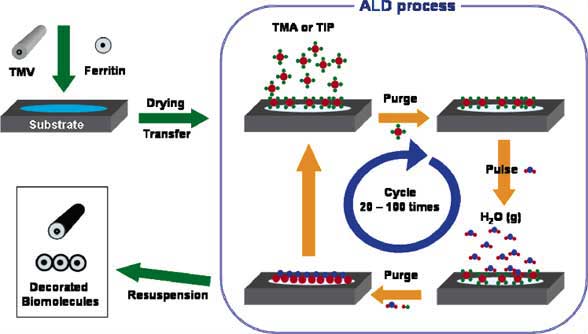| Posted: Jun 29, 2006 | |
Biomolecules as novel templates for the fabrication of nanostructures |
|
| (Nanowerk Spotlight) Applying atomic layer deposition (ALD) to biological macromolecules opens a route to fabricate metal oxide nanotubes and thin films with embedded biomolecules. The combination of biomaterials and ALD does not yet allow for a construction of a device. However, there are some indications that the synthesis of thin films with embedded functional biomolecules, such as ferritin, might be suitable for e.g. flexible electronics. | |
| The research groups using the ALD method are mainly focused on the synthesis of thin films which are or might be of importance in the electronics industry. However, there are some research groups which found that this particular deposition method is suitable for thin film deposition on nanostructures and thus production of new nanostructures. | |
| One such group is at the Max Planck Institute of Microstructure Physics in Halle, Germany. Dr. Mato Knez, together with co-authors from his institute and the Department of Molecular Biology and Plant Virology at the University of Stuttgart, first authored a recent paper on the decoration of biomolecules ("Atomic Layer Deposition on Biological Macromolecules: Metal Oxide Coating of Tobacco Mosaic Virus and Ferritin", published in the April 27, 2006 edition of Nano Letters) | |
| "The main advantage of the ALD method is the precise control of the deposition thickness" Knez explains to Nanowerk. "In our research we added an entirely new parameter: the biomolecules. This possibility has not been shown before." | |
| The German researchers' findings can open doors for the design of a completely new type of nanostructures, constructed of soft (biological) and hard (ALD-deposited) matter. | |
 |
|
| Overview of the experimental process for the coating of the biomolecules by ALD. After drying on a substrate, the biomolecules are transferred to the ALD chamber and exposed to TMA or TIP vapor, the excess of the precursor in the gas phase is purged and the substrate is successively exposed to water vapor. The reaction products and the excess of water are purged. After 20-100 cycles the coated biomolecules are obtained. After removal from the ALD chamber they can be resuspended and analyzed by TEM. (Reprinted with permission from the American Chemical Society) | |
| There is a number of problems which can be solved with this method. Bimolecular assemblies (e.g. protein crystals) can be obtained if they are dried. However, an insertion of inorganic materials (e.g. metal oxides) could only be done in a solvent, which usually disassembles the crystals. | |
| The new process described by Knez and his colleagues allows for the addition of inorganic materials to biostructures in their dry form and enables additional functionalities, if e.g. optically active materials are deposited. The other important point is that the structure of highly ordered biomaterials can easily be replicated with inorganic materials. | |
| "In this way it becomes possible to produce inorganic nanostructures which cannot be obtained by other means" Knez says. | |
| On one hand, narrow pores and channels with less than 4 nm in diameter can be accessed by the precursors and nanotubes can be fabricated; on the other hand the metal oxide deposition of the ferritin molecules shows that ALD can easily be expanded to the fabrication of thin films of interconnected biomolecules and other temperature-sensitive nanoparticles. | |
| Knez says that preliminary results show that their method of ALD coverage of biological macromolecules can be extended to DNA as well. "The chemical or physical properties of the biomolecules can be altered with the metal oxide coating" he says. "Even the replication of highly complex shapes of biomolecules which cannot be generated in a laboratory otherwise can be performed." | |
| Although the work with biomolecules in nanotechnology is still a niche, the community is steadily growing. This can also be seen in the increasing number of publication in this field. | |
| "I would compare it to the transition of fuel-driven cars to the hydrogen-driven ones" Knez explains the future of this new field. "Only few companies are working on this topic and the process needs a lot of time and work. However, hydrogen has unlimited resources and that is the big advantage. With our biomolecules it is similar. Those nanostructures can in most cases be easily reproduced and the resources are unlimited." | |
| "There is enormous potential for the use of such nanostructures as templates in the electronics or optical industry" Knez concludes. | |
 By
Michael
Berger
– Michael is author of three books by the Royal Society of Chemistry:
Nano-Society: Pushing the Boundaries of Technology,
Nanotechnology: The Future is Tiny, and
Nanoengineering: The Skills and Tools Making Technology Invisible
Copyright ©
Nanowerk LLC
By
Michael
Berger
– Michael is author of three books by the Royal Society of Chemistry:
Nano-Society: Pushing the Boundaries of Technology,
Nanotechnology: The Future is Tiny, and
Nanoengineering: The Skills and Tools Making Technology Invisible
Copyright ©
Nanowerk LLC
|
Become a Spotlight guest author! Join our large and growing group of guest contributors. Have you just published a scientific paper or have other exciting developments to share with the nanotechnology community? Here is how to publish on nanowerk.com.
